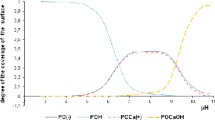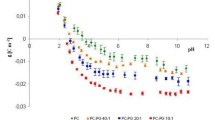Summary
Calcium and other alkaline earth cations change the electrostatic potential adjacent to negatively charged bilayer membranes both by accumulating in the aqueous diffuse double layer adjacent to the membrane and by adsorbing to the phospholipids. The effects of these cations on the electrostatic potential are described adequately by the Gouy-Chapman-Stern theory. We report the results of experiments with ethane-bis-trimethylammonium, a cation that has been termed “dimethonium” or “ethamethonium” in analogy with hexamethonium (hexane-1,6-bis-trimethylammonium) and decamethonium (decane-1,10-bis-trimethylammonium). We examined the effect of dimethonium on the zeta potential of multilamellar vesicles formed from the negative lipid phosphatidylserine (PS) and from 5 ∶ 1 phosphatidylcholine/phosphatidylserine mixtures in solutions containing 0.1, 0.01 and 0.001m sodium, cesium, or tetramethylammonium chloride. We also examined the effect of dimethonium on the conductance of planar PS bilayer membranes and the31P NMR signal from sonicated PS vesicles formed in 0.1m NaCl. We found no evidence that dimethonium adsorbs specifically to bilayer membranes. All the results, except for those obtained with vesicles of low charge density formed in a solution with a high salt concentration, are consistent with the predictions of the Gouy-Chapman theory. We conclude that dimethonium, which does not have the pharmacological effects of hexamethonium and decamethonium, is a useful divalent cation for physiologists interested in investigating electrostatic potentials adjacent to biological membranes.
Similar content being viewed by others
References
Akutsu, H., Seelig, J. 1981. Interaction of metal ions with phosphatidylcholine bilayer membranes.Biochemistry 20:7366–7373
Alvarez, O., Brodwick, M., Latorre, R., McLaughlin, A., McLaughlin, S., Szabo, G. 1983. Large divalent cations and electrostatic potentials adjacent to membranes: Experimental results with hexamethonium.Biophys. J. (in press)
Bangham, A.D., Hill, M.W., Miller, N.G.A. 1974. Preparation and use of liposomes as models of biological membranes.Methods Membr. Biol. 1:1–68
Begenisich, T. 1975. Magnitude and location of surface charges onMyxicola giant axons.J. Gen. Physiol. 66:47–65
Benz, R., McLaughlin, S. 1983. The molecular mechanism of action of the proton ionophore FCCP.Biophys. J. 43:381–398
Bhuiyan, L.B., Outhwaite, C.W., Levine, S. 1981. Numerical solution of a modified Poisson-Boltzmann equation for 1∶2 and 2∶1 electrolytes in the diffuse layer.Mol. Phys. 42:1271–1290
Carnie, S., McLaughlin, S. 1983. Large divalent cations and electrostatic potentials adjacent to membranes: A theoretical calculation.Biophys. J. (in press)
Dani, J., Sanchez, J.A., Hille, B. 1983. Lyotropic anions: Na channel gating and Ca electrode response.J. Gen. Physiol. 81:255–281
Eisenberg, M., Gresalfi, T., Riccio, T., McLaughlin, S. 1979. Adsorption of monovalent cations to bilayer membranes containing negative phospholipids.Biochemistry 18:5213–5223
Fohlmeister, J.F., Adelman, W.J., Jr. 1982. Periaxonal surface calcium binding and distribution of charge on the faces of squid axon potassium channel molecules.J. Membrane Biol. 70:115–123
Frankenhaeuser, B., Hodgkin, A.L. 1957. The action of calcium on the electrical properties of squid axons.J. Physiol. (London) 137:218–244
Gilbert, D., Ehrenstein, G. 1969. Effect of divalent cations on potassium conductance of squid axons: Determination of surface charge.Biophys. J. 9:447–463
Grasdalen, H., Eriksson, L.E.G., Westman, J., Ehrenberg, A. Surface potential effects on metal ion binding to phosphatidylcholine membranes.Biochim. Biophys. Acta 469:151–162
Henry, D.C. 1938. A source of error in micro-cataphoretic measurements with a cylindrical-bore cell.J. Chem. Soc. (London) 997–999
Hille, B., Woodhull, A.M., Shapiro, B.I. 1975. Negative surface charge near sodium channels of nerve: Divalent ions, monovalent ions, and pH.Phil. Trans. R. Soc. London B. 270:301–318
Kostyuk, P.G., Mironov, S.L., Doroshenko, P.A., Ponomarev, V.N. 1982. Surface charges on the outer side of mollusc neuron membrane.J. Membrane Biol. 70:171–179
Kurland, R., Newton, C., Nir, S., Papahadjopoulos, D. 1979. Specificity of Na+ binding to phosphatidylserine vesicles from a23Na NMR relaxation study.Biochim. Biophys. Acta 551:137–147
Lau, A., McLaughlin, A., McLaughlin, S. 1981. The adsorption of divalent cations to phosphatidylglycerol bilayer membranes.Biochim. Biophys. Acta 645:279–292
MacDonald, R.C., Bangham, A.D. 1972. Comparison of double layer potentials in lipid monolayers and lipid bilayer membranes.J. Membrane Biol. 7:29–53
McLaughlin, A. 1982. Phosphorous-31 and carbon-13 nuclear magnetic resonance studies of divalent cation binding to phosphotidylserine membranes: Use of cobalt as a paramagnetic probe.Biochemistry 21:4879–4885
McLaughlin, S. 1977. Electrostatic potentials at membranesolution interfaces.Curr. Top. Membr. Transp. 9:71–144
McLaughlin, S. 1982. Divalent cations, electrostatic potentials, bilayer membranes.In: Membranes and Transport. A. Martonosi, editor. Vol. 1, pp. 51–55. Plenum Press, New York
McLaughlin, S. 1983. Experimental tests of the assumptions inherent in the Gouy-Chapman-Stern theory of the aqueous diffuse double layer.In: Physical Chemistry of Transmembrane Ion Movements. G. Spach, editor. Elsevier, Amsterdam
McLaughlin, S., Mulrine, N., Gresalfi, T., Vaio, G., McLaughlin, A. 1981. Adsorption of divalent cations to bilayer membranes containing phosphatidylserine.J. Gen. Physiol. 77:445–473
McLaughlin, S.G.A., Szabo, G., Eisenman, G. 1971. Divalent ions and the surface potential of charged phospholipid membranes.J. Gen. Physiol. 58:667–687
McLaughlin, S.G.A., Szabo, G., Eisenman, G., Ciani, S. 1970. Surface charge and the conductance of phospholipid membranes.Proc. Natl. Acad. Sci. USA 67:1268–1275
Mozhayeva, G.N., Naumov, A.P. 1970. Effect of surface charge on the steady-state potassium conductance of nodal membrane.Nature (London) 228:164–165
Nir, S., Newton, C., Papahadjopoulos, D. 1978. Binding of cations to phosphatidylserine vesicles.Bioelectrochem. Bioenerg. 5:116–133
Ohki, S. 1981. Membrane potentials, surface potential, and ionic permeabilities.Physiol. Chem. Phys. 13:195–210
Ohki, S., Kurland, R. 1981. Surface potential of phosphatidylserine monolayers: II. Divalent and monovalent binding.Biochim. Biophys. Acta 645:170–176
Schauf, C.L. 1975. The interactions of calcium withMyxicola giant axons and a description in terms of a simple surface charge model.J. Physiol. (London) 248:613–624
Shindo, H., Takahashi, I., Nakajima, E. 1971. Autoradiographic studies on the distribution of quaternary ammonium compounds. II. Distribution of14C-labeled decamethonium, hexamethonium and dimethonium in mice.Chem. Pharm. Bull. 19:1876–1885
Szabo, G., Eisenman, G., McLaughlin, S.G.A., Krasne, S. 1972. Ionic probes of membrane structure.Ann. N.Y. Acad. Sci. 195:273–290
Tocanne, J.F., Tichadou, J.L., Lakhadar-Ghazal, F. 1983. Influence du pH et de la force ionique sur le degre d'ionisation de phospholipides acides dans des systemes modeles de membranes.In: Physical Chemistry of Transmembrane Ion Movements. G. Spach, editor. Elsevier, Amsterdam
Torrie, G.M., Valleau, J.P. 1982. Electrical double layers: 4. Limitations of the Gouy-Chapman theory.J. Phys. Chem. 86:3251–3257
Wiersema, P.H., Loeb, A.L., Overbeek, J.T.G. 1966. Calculation of the electrophoretic mobility of a spherical colloid particle.J. Colloid Interface Sci. 22:78–99
Author information
Authors and Affiliations
Rights and permissions
About this article
Cite this article
McLaughlin, A., Eng, WK., Vaio, G. et al. Dimethonium, a divalent cation that exerts only a screening effect on the electrostatic potential adjacent to negatively charged phospholipid bilayer membranes. J. Membrain Biol. 76, 183–193 (1983). https://doi.org/10.1007/BF02000618
Received:
Issue Date:
DOI: https://doi.org/10.1007/BF02000618




